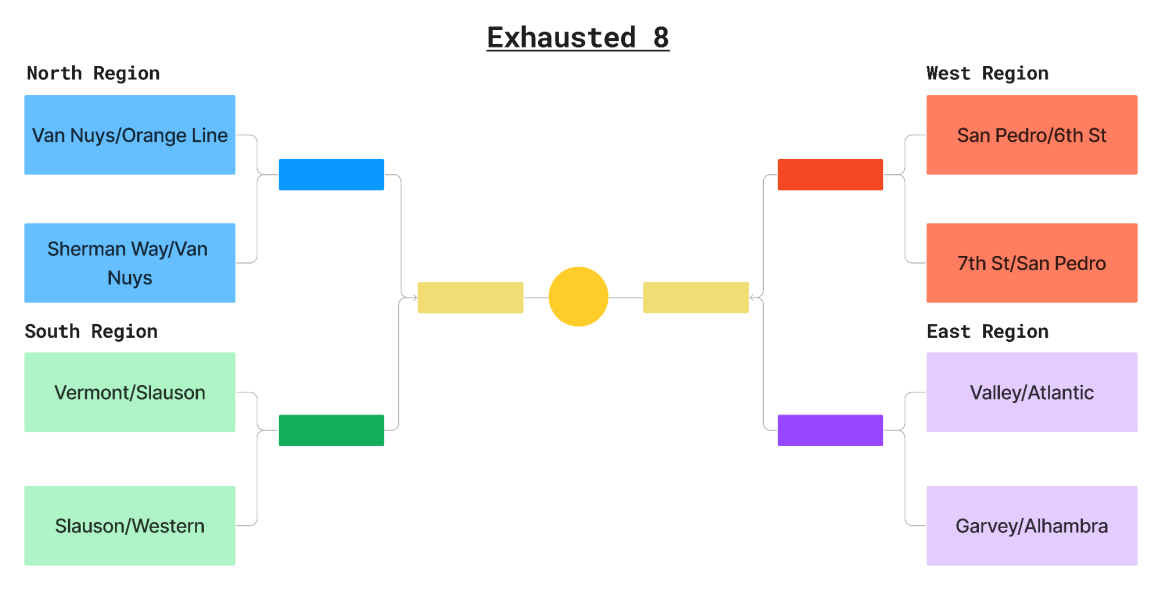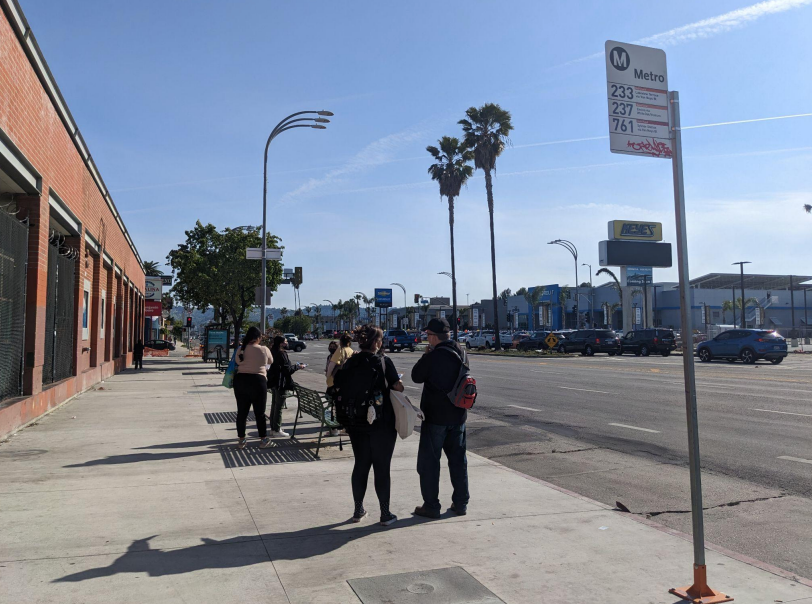LA2050 Blog
We’ve got access to the information that every Angeleno needs to make an impact. Our blog features the latest LA2050 news, announcements, features, happenings, grantee updates, and more.

The Results Are In – The Final 4 of Climate Resolve's Bus Stop Heat Bracket
PostedOver the course of the past few months, over 200 community members voted in the Climate Resolve “Hottest in LA: the Bus Stop Heat Bracket,” funded by LA2050 and the Goldhirsh Foundation. The Bracket consisted of the hottest, most-used bus stops in Los Angeles County
that are most in need of improvements. Community votes helped us narrow down the Bracket from the original 32 bus stops to the “Sweaty 16” and then to the “Exhausted 8."

Once we reached our “Exhausted 8,” Climate Resolve staff went out to conduct surveys asking over 125 transit riders about their experience at each bus stop. Questions touched on current wait times, bus stop conditions, safety, and general stop improvement recommendations.
Community Surveys

A majority of transit riders we interviewed reported wanting to see a combination of shade and protection from the elements, better lighting to bolster safety, increased frequency during off-peak hours, and more diligent maintenance at bus stops. It's not uncommon for passengers to find themselves in a tough spot, torn between seeking slivers of nearby shade and the risk of missing their bus. Oftentimes, due to the lack of shade at stops, riders venture away from their designated spots in search of cover, but this can inadvertently hide them from the watchful eyes of bus drivers. Frustratingly, more than once, respondents recounted dashing out from their shady refuge only to watch helplessly as bus drivers skipped their stop and continued on their way. To avoid this recurring disappointment, many have reluctantly forsaken the quest for shade, opting instead to endure the scorching sun.

In regard to transit service, our interviews uncovered differences in experiences between peak and off-peak hours, where some passengers praised the frequency of buses during rush hours, with some willing to wait for as long as 15 minutes. However, safety concerns arise when discussing off-peak hours, particularly among women getting off work during these times. They are especially concerned about safety at bus stops and believe that striking a balance between improved lighting and more frequent and reliable service during off-peak hours would be the optimal solution.
Notably, bus riders, especially those using the South Region stops, have identified a lack of maintenance at bus stops as a major concern. They frequently point out that most bus stops along main corridors, like Slauson Avenue, are devoid of trash cans, resulting in an accumulation of litter, which, unfortunately, attracts more bugs. They eagerly hope for increased available trash cans and overall maintenance at these stops. The feedback from transit riders,
who rely on this vital public service, underscores the urgent need for shelter, improved lighting, bus frequency, and maintenance at bus stops to enhance comfort, safety, and overall service quality.
Driving Community Feedback Forward
As our voting process progressed, moving from the "Exhausted 8" to the "Final 4," Climate Resolve actively collaborated with fellow transit advocacy organizations, including Move LA, Koreatown Immigrant Workers Alliance (KIWA), and Strategic Actions for a Just Economy (SAJE). This collaborative effort sought to gather valuable community insights that would shape much-needed bus stop amenities and our shelter design renderings. Additionally, as part of our outreach efforts, Climate Resolve staff engaged in a conversation with reporter Erin Stone from LAist, emphasizing the significance of adding shelter and other amenities to our bus stops, particularly in response to the increasing prevalence of extreme heat waves affecting Los Angeles County.

All the valuable feedback we collected up to this point was also shared in meetings with the Tranzito-Vector team and LA City Sidewalk and Transit Amenities Program (STAP), who were looking for feedback on their own bus shelter designs for LA City. It's essential to understand that, in many instances, the decision to install a bus shelter lies within the domain of the local municipality, given their authority over the public right-of-way where these shelters are situated.
Moreover, it's worth noting that the provision of bus stop amenities in cities such as Los Angeles typically involves external advertising agencies operating under contractual agreements, as is the case with Tranzito-Vector.
During continued conversations, we gained valuable insights into their installation strategy, which centers on replacing existing shelter locations, particularly those serving the highest number of riders. Simultaneously, they are committed to refurbishing shelters that are relocated to new sites without shelters, referred to as interim shelters. The good news for our team is that a significant portion of the 32 bus stops within Los Angeles City boundaries fall under the category of “priority interim sites.” This designation puts them in strong consideration for interim shelter installation. For bus stops outside Los Angeles City boundaries, our Climate Resolve team has remained in active communication with the San Gabriel Valley Council of Government's (SGVCOG) Transportation Committee, ensuring that community feedback continues to be shared and considered.
Bus Shelter Renderings

After completing our community surveys, we compiled all feedback and sent over parameters to our digital artist, Cary Ng, who created renderings of what an ideal “bus shelter” would look like.

The general preference for the transit riders we engaged was to have an open design for the bus shelter, extending the canopy as much as possible around the seating for optimal cover. In the event that transit riders do step away from the bus stop, there was a button added to the bus stop that would alert the bus driver of someone waiting for the bus. This button would also help folks who have disabilities to notify the bus driver of their presence at the stop. Moreover, our rendering artist made sure to include lighting under the shelter to help illuminate the bus stop at night as well. Community members also mentioned wanting to see more art at the bus shelters instead of advertisements, so our rendering artist added a panel that can be used to display art commissioned by local artists and have that posted at the shelter.

Rendering for the Sherman Way / Van Nuys Blvd Bus Stop

Rendering for the Slauson Ave / Western Ave Bus Stop

Rendering for San Pedro St / 6th St

Rendering for Valley Blvd / Atlantic Blvd
Climate Resolve is excited to share these renderings widely with our community partners, Tranzito-Vector, SGVCOG, and the community at large. We will also share them via social media and in our newsletter. By continuing to engage our partners and community members, we can ensure that the bus shelter design reflects what the community is looking for.
What’s coming ahead for transit amenities?
For the past few years, Climate Resolve has been building momentum around the importance of improving bus stop conditions, including adding more shelters for our transit riders. Through our sustained efforts and collaboration with MoveLA and fellow transit organizations, we are delighted to announce the following significant milestones: the approval by the LA City Council of the Reinvestment in Accessibility, Infrastructure, and Streetscape Enhancements for Los Angeles (RAISE LA) fund. This groundbreaking ordinance marks a pivotal moment as it designates all advertising revenues collected from the STAP program to the improvement of accessibility, shade, and overall condition of streetscapes and public rights of way within Los Angeles City. Additionally, Mayor Karen Bass has approved a $30 million Public Works Trust Fund loan. This funding will be instrumental in the installation of new transit shelters at locations currently lacking such infrastructure, such as the bus stops in our bracket. Furthermore, it will also include the revitalization of existing structures, ensuring a more comfortable and accessible public transit experience for all residents of LA City.
Moreover, there's significant news for our transit riders in the San Fernando Valley: LA Metro’s North San Fernando Valley Transit Corridor Project has committed to invest in bus priority infrastructure, improved service frequency, and 400 new bus shelters with changes starting this past summer and finishing up in 2025. This project is a vivid testament to the collective efforts of transit advocates, prompting LA Metro to recognize the profound need for their active involvement in the enhancement of bus stops. It emphasizes the necessity of allocating additional resources to leverage action from the diverse cities within its jurisdiction. These exciting investments in transit amenities and infrastructure will transform the transit rider experience for residents across LA County.
Reflections and next steps
Running our social media campaign brought with it many successes, along with some challenges. By hosting our bracket on social media, along with in-person surveys, our goal was to try to broaden the audience we engage around both the project and the subject – getting more transit amenities installed at our bus stops.
While our online engagement indicated a genuine interest in the subject, with over 3,400 interactions with our content, we noticed that some potential participants may have been somewhat reluctant to actively partake in the voting process of our bracket. This could have been improved by incorporating other media types, such as photos or videos, to effectively convey key elements, including
- Showcasing the actual conditions of bus stops within our bracket to provide a tangible perspective on the compelling need for better-maintained transit amenities.
- Offering a firsthand glimpse into the experiences of riders by sharing the temperature on the days when our staff conducted surveys.
- Adapting our language in posts to make the content more accessible to the specific audience we aimed to engage.
By considering these adjustments, we hope to make future campaigns more engaging and inclusive, ensuring that they resonate with our target audience and effectively address their interests and concerns.
Additionally, although we had hoped for a more profound level of engagement on our social media platforms, we found invaluable insights through face-to-face interactions with both community members and fellow transit advocates. Their feedback was instrumental in shaping the design of our renderings. With the infusion of new investments into transit amenities, the Climate Resolve team is currently in the process of scheduling meetings to gain a deeper understanding of how this funding will impact the ongoing bus shelter implementation plan. We remain fully committed to active collaboration with transit advocacy organizations and their dedicated memberships, ensuring that the forthcoming phase—the deployment strategy for bus shelters and other transit amenities—is carried out in an equitable and priority-focused manner, addressing the areas where it's most urgently needed.
To announce the groundbreaking investments in bus shelter infrastructure across Los Angeles, including the passage of the RAISE LA fund, approval of the LA City Department of Public Works loan, and the LA Metro North San Fernando Valley project, Climate Resolve, in collaboration with MoveLA and other LA City representatives, is working diligently to organize a press conference. This event aims to unite stakeholders and share the momentous news with residents, securing media coverage and underscoring Los Angeles' historic commitment to addressing the longstanding disparity in bus shelter access.
Our work doesn't conclude here, and we extend our heartfelt appreciation to the LA2050 team and the Goldhirsh Foundation for their unwavering support in this campaign, which seeks to benefit all transit riders across LA County.